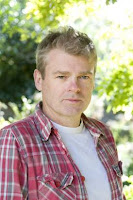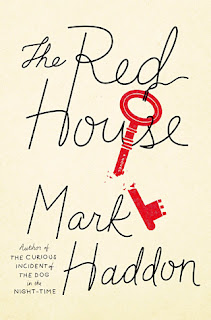It is a bit difficult to get into the rhythm of Mark
Haddon’s The Red House, but readers
who stick with Haddon to the end will be well rewarded for their
persistence. The book focuses on eight
central characters, all of them related either by blood or marriage, who are
sharing a vacation home in the English countryside for a week of getting acquainted/reacquainted. Richard, a wealthy physician, and his sister
Angela have been estranged for a number of years. Prompted by the recent death of their mother,
Richard would like to reconcile with Angela and her family. Accompanying Angela to the rented
Herefordshire house is Dominic, her husband, and their three children: Alex
(17), Daisy (16), and Benjy (8). Richard
brings his second wife, Louisa, and Louisa’s 16-year-old daughter, Melissa.
The Red House is
divided into eight sections, beginning on the Friday everyone arrives, and
ending on the following Friday morning when the frazzled families depart for
home -an organized and logical way to subdivide the story. However, the narrative is not that
straightforward. The off-putting bit
stems from the manner in which Haddon introduces each of his main characters by
allotting each a random stream-of-consciousness paragraph of their own. Before meeting the characters in any context,
the reader is suddenly placed inside the heads of eight very different
people. Thankfully, although Haddon
continues this approach to the last page, the characters will eventually become
distinct, perhaps even clearer and better defined than if he had taken a more
direct approach with them.
 |
| Mark Haddon |
Eight people share the same red house, but each seems to be
very much alone, harboring individual concerns that have very little to do with
anyone around them. This is not
particularly surprising about the three teens, but their parents seem to be every
bit as insulated as Alex, Daisy, and Melissa.
Even little Benjy, a precocious little boy, is happy to exist in his own
world – a world in which he is a highly effective little warrior/death
machine.
Angela is feeling the melancholy of her mother’s death and
questions the strength of her marriage; her husband feels himself to be an
inadequate provider, especially when he compares himself to Angela’s
doctor-brother; Richard is uneasy about the aftermath of a surgery that left a
little girl paralyzed and is unsure that he will keep his medical license; and
his new wife is concerned that he might learn the details of her sordid
past. As for the teens, of course, all
they think about is sex – even when they try not to.
The Red House is a
first rate domestic drama. It is
certainly not a feel-good book, but it offers insights into the isolation and
self-centeredness that so many feel even when surrounded by “loved ones,”
especially loved ones who feel just as isolated as them.
Despite the likely temptation to do so, do not give up on
this one too early because, as soon as the characters become recognizable as
individual voices, it has a lot to say.

Thank you for this wonderfully written review, Sam.
ReplyDeleteI loved Mark Haddon's other books -- I'm going to wait until this one comes out in trade-paper edition [as I am waiting also for the new John Irving one, in a similar way] -- but you have made me want to read it.
For sure.
He is a royal hoot.
I feel that he is a sort of Richard Russo author, but BETTER at the humor end of it.
Cip, this dude (Mark Haddon) can write. I've read two of his now, and loved both of them.
ReplyDeleteI would have to show a lot of reading fortitude for this one. I get put off by stream of consciousness since Faulkner traumatized me with Of Sound and Fury! :)
ReplyDeleteKathleen, The Red House does take a little getting used to, but once you get into the books rhythm (isn't that always the way, though), it really starts to flow well and you feel as if you know and understand all of the characters really well.
ReplyDelete